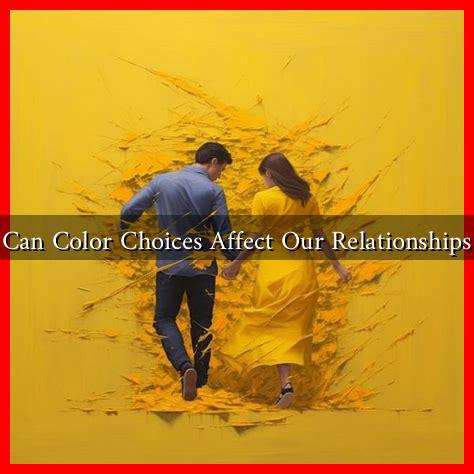-
Table of Contents
Can Color Choices Affect Our Relationships?
Color is an integral part of our daily lives, influencing our emotions, perceptions, and even our interactions with others. From the clothes we wear to the decor in our homes, color choices can subtly shape our relationships. This article explores how color can affect our relationships, backed by research, examples, and insights.
The Psychology of Color
Color psychology is the study of how colors affect human behavior and emotions. Different colors evoke different feelings and associations, which can influence how we relate to others. Here are some key colors and their psychological effects:
- Red: Often associated with passion and love, red can stimulate excitement and energy. However, it can also evoke feelings of anger or aggression.
- Blue: Known for its calming effects, blue can promote feelings of trust and security, making it a popular choice in corporate branding and social settings.
- Yellow: This bright color is linked to happiness and optimism. It can foster a sense of warmth and friendliness, but too much yellow can lead to feelings of anxiety.
- Green: Symbolizing nature and tranquility, green can create a sense of balance and harmony, making it ideal for spaces meant for relaxation and connection.
- Purple: Often associated with luxury and creativity, purple can inspire imagination and spirituality, enhancing deeper connections.
Color in Personal Relationships
Color choices can significantly impact personal relationships, from romantic partnerships to friendships. Here are some ways color influences these connections:
- Clothing Choices: The colors we wear can affect how others perceive us. For instance, wearing red on a date may convey confidence and passion, while blue may suggest calmness and reliability.
- Home Decor: The colors in our living spaces can influence the mood and dynamics of our relationships. Warm colors like orange and yellow can create a welcoming atmosphere, while cooler colors like gray may evoke a more subdued environment.
- Gift Giving: The color of gifts can also carry meaning. For example, red roses symbolize love, while yellow flowers may represent friendship. Choosing the right color can enhance the emotional impact of a gift.
Case Studies and Research Findings
Several studies have explored the relationship between color and interpersonal dynamics. For instance, a study published in the journal “Color Research and Application” found that individuals wearing red were perceived as more attractive and desirable in social settings. This suggests that color can play a role in initial attraction and relationship formation.
Another study conducted by the University of British Columbia revealed that people are more likely to cooperate and engage positively in environments painted in warm colors compared to those in cooler tones. This finding highlights how color can influence group dynamics and social interactions.
Color in Professional Relationships
In professional settings, color choices can also impact relationships and perceptions. For example:
- Branding: Companies often use specific colors in their branding to evoke certain feelings. For instance, blue is commonly used by tech companies to convey trust and reliability.
- Office Design: The color scheme of an office can affect employee morale and collaboration. Open spaces with vibrant colors can foster creativity, while muted tones may lead to a more serious atmosphere.
Conclusion
Color choices play a significant role in shaping our relationships, influencing everything from initial attraction to long-term connections. Understanding the psychological effects of color can help us make more informed choices in our personal and professional lives. By being mindful of the colors we wear, the environments we create, and the gifts we give, we can enhance our interactions and foster deeper connections with others.
In summary, color is not just a visual experience; it is a powerful tool that can affect our emotions and relationships. Whether you are looking to strengthen a romantic bond, improve friendships, or enhance professional interactions, consider the impact of color in your choices. For further reading on color psychology, you can explore resources like the Color Psychology website.

